There is no shortage of poke bars to buy from, but most of them seem to coat the fish with a sweet soy sauce dressing. However, the original Hawaiian poke recipe does not use soy sauce at all and is perfectly keto.
Poke can be served with corn chips, but for keto options serve this poke alongside a seaweed salad, quick cucumber kimchi, or a silky cool tofu salad.
What is Poke?
First, it is pronounced poh-kay, not poke or poh-kee. It is the Hawaiian word for "slice or cut" or "section."
The dish originated from native Hawaiian fishermen as a simple way to prepare the day's catch.
The fishermen used what they had on hand to season the fish, including sea salt, seaweed, and candlenuts, and ate it raw.
Poke is now a worldwide rock star paired with a number of supporting flavors and beloved like sushi.
Traditional Hawaiian Poke
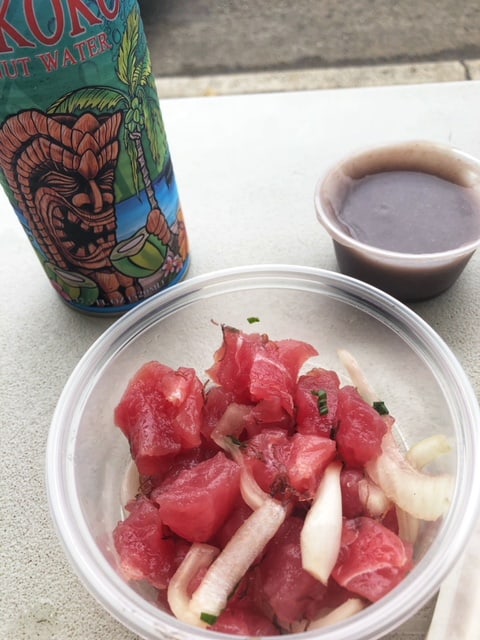
Poke, as pictured above from Pono Market in Kauai, is most commonly bought not at restaurants but at markets in the deli case in Hawaii.
It is scooped up into round plastic containers that you pay for by the pound.
This traditional version, also called Onion Poke, is fairly simple with just a bit of sweet onion, green onion, and faint strips of purple seaweed known as ogo.
Ogo: the secret seaweed seasoning
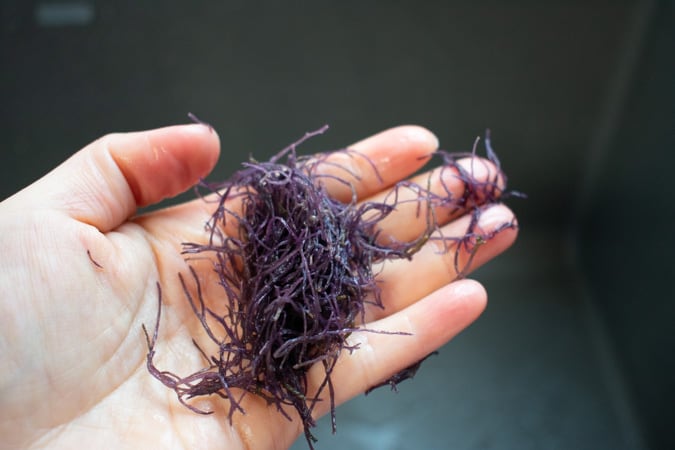
Ogo is the traditional seaweed used to season Hawaiian poke.
Outside of Hawaii, it is a bit harder to find fresh or frozen, so it works wells to purchase it dried and rehydrate in water.
When raw, ogo ranges in color from purple to reddish brown.
- When cooked, it turns dark green.
- When soaked in alcohol, it turns bright orange.
- What other ingredient is quite so colorful?
- Pastry chefs sometimes play with its thickening qualities.
- It is one of the seaweeds used to make agar, the vegan thickening powder. (Traditional gelatin is made with pork collagen).
Ogo and the seasonings for this recipe can be found in this easy to use poke seasoning packet.
What kind of tuna should you use?
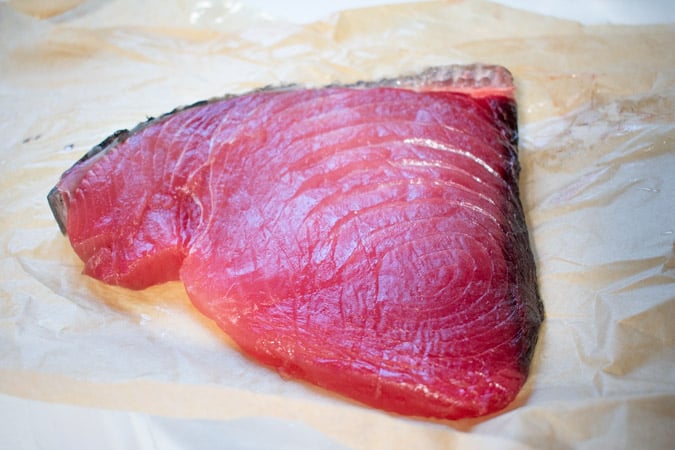
Tuna sold in stores usually comes in four varieties:
- Skipjack - I'm not sure what this tastes like
- Ahi - The ideal choice. Clean, mild in flavor, and bright pink.
- Bluefin - Also bright pink, but more oily, unctuous, and full flavored.
- Albacore - White fish often found in cans. Tastes wonderful fresh but not typically used for poke.
Since this is a raw preparation, you will need to find a sashimi grade tuna other fish that sold specifically for raw consumption.
In Hawaii, ahi tuna would typically be used for poke, since it is so readily available off their vast coastlines.
This poke recipe, however, can also be made with other fish such as:
- yellowtail
- tako (cooked octopus)
- cooked clams
- cooked mussels
You could also use salmon, but salmon is typically prepared with tomatoes in a different recipe called Lomi Lomi Salmon.
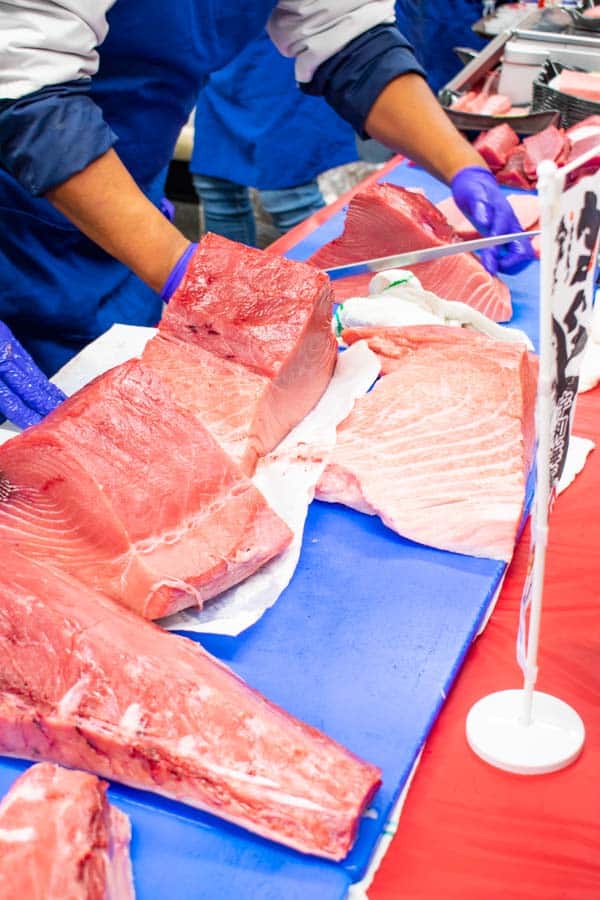
Fresh tuna is not cheap
I suppose you can guess the quality of the tuna by the price.
Cheaper tunas will be gassed with carbon monoxide.
Yes, tuna can be gassed so it stays bright and ferociously pink.
Old tuna turns brown quickly, but the carbon monoxide perks it right back up to pink and should be avoided at all cost.
Canada, Japan, and the European Union have banned the practice, but the FDA has lagged behind in regulation.
Perhaps the hardest part of this recipe is sourcing quality fish.
How to make Legitimate Hawaiian Poke
Step 1: Rehydrate Seaweed
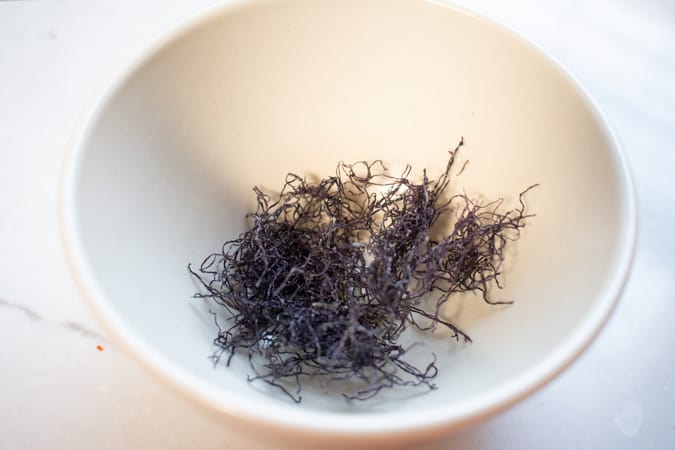
Take the dried ogo seaweed and cover with water.
If you can't find ogo, you can use:
- dried wakame, rehydrated in water
- nori strips
- or even pre-made Japanese seaweed salad would work
After at least 5 minutes, you can drain and chop into ¼" pieces.
Step 2: Cut tuna & sweet onion
Traditional Hawaiian poke uses sweet Maui onion.
Any sweet onion, such as Vidalia or Walla Walla, would work well.
If you can't find sweet onion, rinse a sliced white onion under water to remove the biting sulfuric acid.
Cube the tuna into ½" chunks.
If you are using sashimi grade tuna, there should be little sinew or black bloodlines included. If there are, cut those items away.
If you do have some sinew, you can also scrape the tuna off with a spoon. We did that in restaurants all the time, so we wouldn't waste any of the precious fish.
It does not all have to be in perfectly cut little squares, so do the best you can!
Step 3: Mix in the Hawaii
Mix the tuna, onion, and rehydrated seaweed with sea salt, chopped green onion, sesame oil, and some chili flakes.
If you don't have sesame oil, a mild olive oil works nicely too.
Hawaiian sea salt is reddish/orange in color. Use if you have, otherwise, any other sea salt would be fine.
This can be done many hours in advance, and the tuna will improve in flavor as the salt cures the fish.
However, do eat on the same day.
The seasoning packet of dried ogo seaweed, Hawaiian sea salt, and chili can be found in this seasoning packet.
No soy sauce needed, and you don't miss it either.
Wine Pairing: Pouilly-Fume
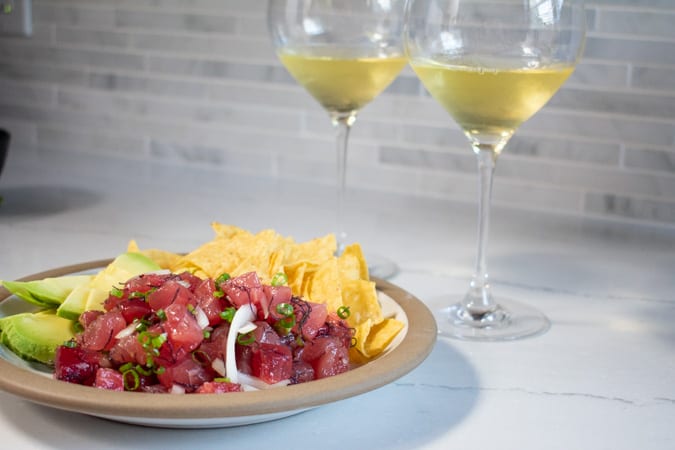
Pronounced pwee-foo-may, it is from Loire region located in northwestern France. The region has been growing grapes since the Medieval Ages until the late 1800s when phylloxera and mildew decided to wipe everything out.
Sauvignon Blanc grapes were planted with the help of American rootstock. However, the French name their wines after the region, not the grape.
The town is Pouilly-sur-Loire. The wine is named Pouilly Fume, since fume means smoke in French. The smoke refers to the gray bloom on the grapes at maturity and the smokey, mineral characteristics of the wine.
A designated Apellation de origine controllee (AOC) since 1937, it is not to be confused with Pouilly-Fusse, a Chardonnay from Burgundy. (Even though, it is kind of confusing).
Sauvignon Blanc grape thrives in this cool climate or Pouilly-sur-Loire, flanked by the Atlantic Ocean and Loire River. It makes a fuller and less spicy wine than Sancerre grown in the neighboring town, and it's soil contains more limestone and flint.
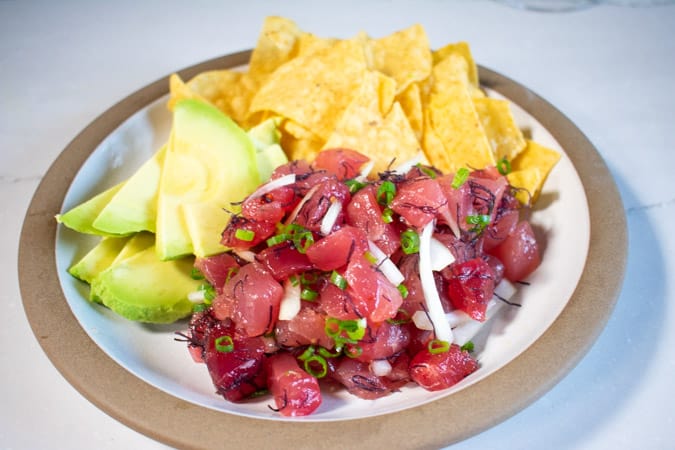
Tips to make it better @home
- Serve over rice, salad greens or corn chips. Avocado is also a must with raw fish.
- You can purchase a premade seasoning packet of dried ogo seaweed and Hawaiian red sea salt.
- This can also be made with yellowtail, cooked octopus/clams/mussels, salmon, or any other sashimi grade fish meant for raw consumption.
- Don't waste any of the tuna. If the tuna has white sinew bits, scrape away the flesh with a spoon. It doesn't all have to be in perfect cubes.
- Cheap raw tuna will be gassed with carbon monoxide to retain the pink color. Buy fresh, high quality, non-gassed fish instead.
- This should be eaten the same day but can be made up to 8 hours ahead of time. The salt cures the fish as it sits, so it will improve in flavor over a few hours.
- If you do have some sinew, you can also scrape the tuna off with a spoon and add it to the poke.
Related Posts
Easy Korean Seaweed Salad Recipe (Vegan & Paleo)
Quickie Miso-Mirin Manila Clams
Top 5 Food Gifts for the Kauai-phile
Recipe
Legitimate Hawaiian Poke (& Keto)
Ingredients
- 2 Tb ogo seaweed, dried use nori strips or rehydrated wakame seaweed as a substitute
- 1 lb sashimi grade tuna loin or other sashimi grade fish you would like to eat raw
- ¼ c sweet onion, sliced ¼" thick or red/white onion rinsed under water
- 1 Tb sesame oil or olive oil
- 2 teaspoon Hawaiian red sea salt or other salt to taste
- 1 Tb thin sliced green onion
- ¼ teaspoon red chili flakes such as Japanese schichimi pepper optional for spice
Instructions
- If using dried ogo seaweed, soak in water for about 5 minutes. Drain, squeeze out excess water, and rough chop into ¼" pieces.
- Cut tuna into ½" dice. Be sure to remove any tough white sinew by using a spoon to scrape off the tuna.
- Toss cubed tuna with onion, sesame oil, green onion, sea salt and chili flakes if using. Store for up to 6-8 hours before serving.
Notes
- Serve over rice, salad greens or corn chips. Avocado is also a must with raw fish.
- You can purchase a premade seasoning packet of dried ogo seaweed and Hawaiian red sea salt.
- This can also be made with yellowtail, cooked octopus/clams/mussels, salmon, or any other sashimi grade fish meant for raw consumption.
- Don't waste any of the tuna. If the tuna has white sinew bits, scrape away the flesh with a spoon. It doesn't all have to be in perfect cubes.
- Cheap raw tuna will be gassed with carbon monoxide to retain the pink color. Buy fresh, high quality, non-gassed fish instead.
- This should be eaten the same day but can be made up to 8 hours ahead of time. The salt cures the fish as it sits, so it will improve in flavor over a few hours.
- If you do have some sinew, you can also scrape the tuna off with a spoon and add it to the poke.
Nutrition
Do you love Hawaiian poke? Please spread the Asian ♥ and share!



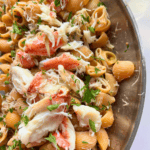



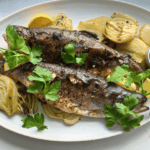


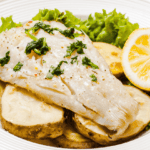


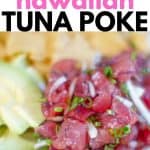
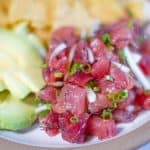
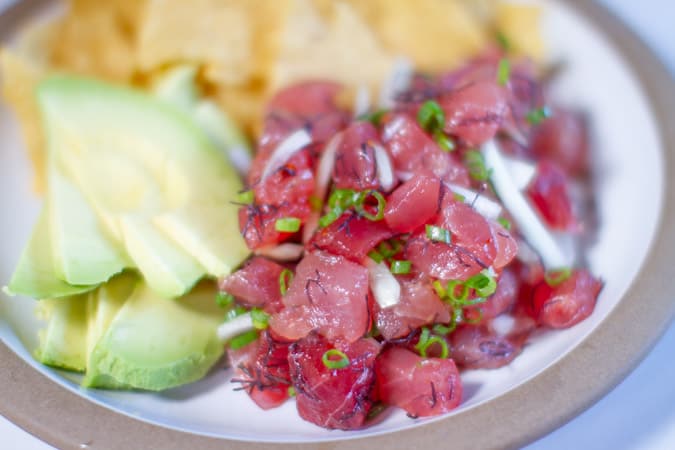
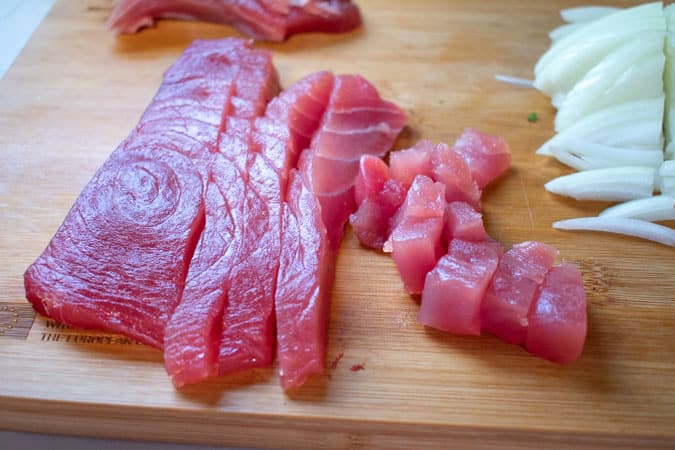
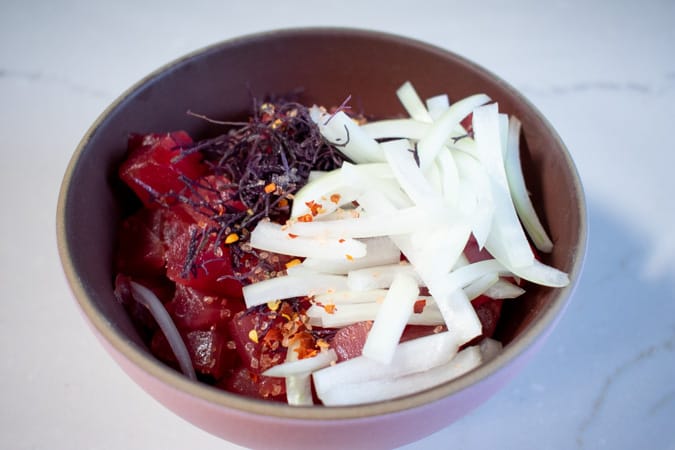




Leave a Reply